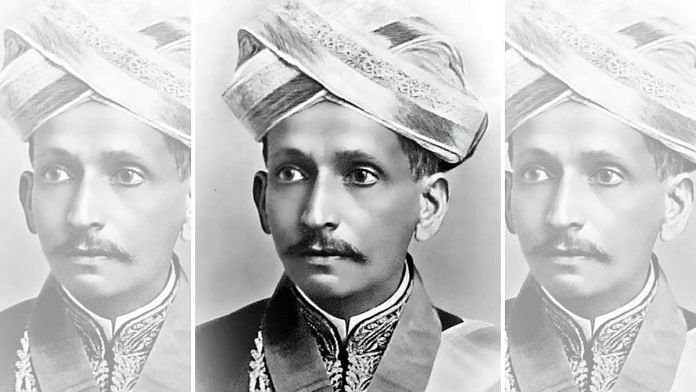New Delhi: “Science is about knowing. Engineering is about doing.” Bharat Ratna awardee Mokshagundam Visvesvaraya lived by these words till his last breath, and came to be known as India’s greatest civil engineer — so much so that every year, the country celebrates his birth anniversary on 15 September as ‘Engineers’ Day’.
Visvesvaraya is best known for designing one of India’s first flood protection systems, in Hyderabad, and setting up one of the first engineering institutes in the country, the Government Engineering College, now called University Visvesvaraya College of Engineering, Bengaluru. But he is also infamous for his stance on caste, and is viewed to have been protective of Brahmins’ status in positions of influence.
Visvesvaraya, widely known as ‘Sir MV’ after being knighted by the British, was born into a poor Brahmin family in Muddenahalli village of what is now Karnataka on 15 September 1861. His father, a well-known Sanskrit scholar of his time, insisted on a quality education for Visvesvaraya. Despite losing his father at the age of 15, Visvesvaraya continued studying by tutoring young kids to earn money. He later moved to Bangalore, as it then was, and attended Wesleyan Mission High School and completed his Bachelor of Arts degree from Central College in 1881.
“Visvesvaraya became part of folklore as a student who struggled and succeeded despite coming from a poor family. He is an icon for engineers across the country,” Chandan Gowda, Ramakrishna Hegde Chair Professor of Decentralisation and Development at Institute for Social and Economic Change, told ThePrint.
Also read: Mir Osman Ali Khan, Hyderabad Nizam who wore cotton pyjamas & used a diamond as paper weight
Unparalleled innovator
Sir MV carried out various significant initiatives throughout his life, be it water reservoirs, town planning or industry and commerce.
One of his major contributions was the Krishnarajasagara (KRS) reservoir on the Kaveri river, of which Mahatma Gandhi said: “KRS alone, one of the largest of its kind in the world, would perpetuate the name of Sir MV.”
Visvesvaraya’s other inventions included designing the block system of irrigation, which ensured even distribution of water supply to parched agricultural lands across a number of villages, and the introduction of automatic sluice gates on dams, which enabled storage of water well above the crest of the weir of the dam.
Thanks to his initiatives as the chief engineer to the Mysore administration in 1909, Visvesvaraya was made the ‘diwan’ of the state in 1912. In his first six years as diwan, he set up 6,500 new schools and drew up legislation to make primary education compulsory for every child. He also played a major role in setting up Hindustan Aeronautics Limited, which would go on to manufacture fighter aircraft for the Indian Air Force, among other achievements.
Champion of the Western model
Visvesvaraya was one of the first scholars in India to vouch for a Western industrial-capitalist model of development, where agriculture became almost completely irrelevant.
“Visvesvaraya, like Nehru, wanted India to opt for a Western model of economic development, which held industrialisation as desirable and inevitable. For him, an agrarian way of life stood for a primitive social order,” said Gowda, adding that Mahatma Gandhi’s moral vision refuted such a view of history and economics.
“Similarities can be seen in Sir MV and Nehru’s visions of modern India. Both, for instance, upheld secular ideals and saw the religious beliefs of Indians as an obstacle to rational thought,” he added.
Allegations of casteism
One of the most controversial episodes of Sir MV’s life came when he stepped down as diwan in protest over the Maharaja of Mysore’s decision to act upon a report filed by a committee headed by Leslie Miller, the chief justice of the princely state, which was formed to look into ways the government could encourage people from non-Brahmin communities to seek employment under the government.
“Visvesvaraya’s resignation has often been viewed as being motivated by a desire to protect upper-caste privilege,” said Gowda.
“He was a meritocrat, but calling him casteist because of this particular incident is not correct. He looked at the problem of caste inequality from an economic point of view, which made him bemoan that caste struggles led to inefficiency and a loss of energy that could be more fruitfully deployed for social gain,” Gowda explained.
“A liberal and gradualist on the issue of achieving caste equality, he held that law and education went a long way in this regard, while also seeing an influential role for community leaders in the work of removing caste-related social disabilities. He wished that members of different castes married freely without any restrictions,” he added.
(Edited by Shreyas Sharma)
(This article has been updated to better reflect the views of Chandan Gowda)
Also read: Rani Gaidinliu, ‘daughter of the hills’ who spent 14 years in jail for India’s independence



